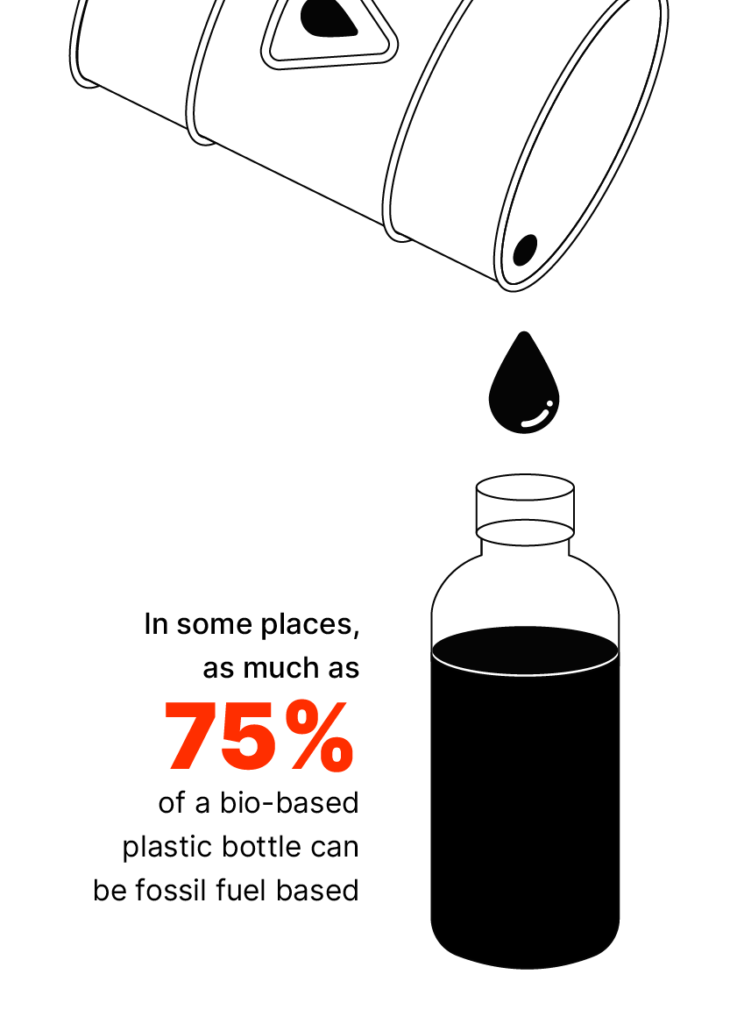- Bio-based plastics
- Biomass-based plastics
-
Bioplastics ambiguous term due to multiple definitions, see Bioplastics Clarification Page for more information
Bio-based plastics are plastics that are partly or entirely made from biological feedstocks((While the biological feedstocks for bio-based plastics are often described as “renewable,” their environmental impact is highly dependent on the land-use and agricultural practices used in growing them.)) such as sugar cane, corn, or potato starch. Most bio-based plastics also contain fossil fuel-based materials, which can in some cases make up as much as 75% of the product.((Surfrider Foundation Europe. (2020). Plastic Fakeout: Falling Into the Trap of Bioplastics. https://surfrider.eu/wp-content/uploads/2020/07/fbi_bioplastic_en.pdf))((Eunomia. (2020). Relevance of Biodegradable and Compostable Consumer Plastic Products and Packaging in a Circular Economy: Final Report. European Commission DG Environment. https://op.europa.eu/en/publication-detail/-/publication/3fde3279-77af-11ea-a07e-01aa75ed71a1/language-en/format-PDF)) These blended materials, as well as purely bio-based polymers, are often chemically and functionally identical to conventional plastics.
The terms bio-based and biodegradable are often, incorrectly, used interchangeably, with the assumption that bio-based plastics behave like biodegradable/compostable plastics. “Bio-based,” however, only refers to the material that is used to make the plastic, regardless of end-of-life behavior, while “biodegradable” describes how the material breaks down (see the bioplastics clarification page for more information).
Some bio-based plastics are also biodegradable, but many are not. In both cases, bio-based plastics can behave like ordinary plastics in the real world, persisting for years when littered and contributing to microplastic pollution as they fragment into smaller pieces.


Examples
Bans & Restrictions
While there are no major bans on bio-based plastic itself, many jurisdictions around the world have banned thin plastic bags and other single-use plastics like straws, including those made from bio-based plastics.((Masterson, V. (2020, October 26). As Canada bans bags and more, this is what’s happening with single-use plastics around the world. World Economic Forum. https://www.weforum.org/agenda/2020/10/canada-bans-single-use-plastics/))
Assessment
In most cases, bio-based plastics mirror the function and end-of-life behavior of conventional plastics, and therefore do not help reduce plastic waste or plastic pollution. The main purported benefit of bio-based plastics is that they are made from renewable materials (agricultural products) instead of fossil fuels. However, in some cases, plastics only have to be 20% bio-based to meet certification requirements,((Eunomia. (2020). Relevance of Biodegradable and Compostable Consumer Plastic Products and Packaging in a Circular Economy: Final Report. European Commission DG Environment. https://op.europa.eu/en/publication-detail/-/publication/3fde3279-77af-11ea-a07e-01aa75ed71a1/language-en/format-PDF)) with fossil fuel-based materials and additives making up the other 80%.((Surfrider Foundation Europe. (2020). Plastic Fakeout: Falling Into the Trap of Bioplastics. https://surfrider.eu/wp-content/uploads/2020/07/fbi_bioplastic_en.pdf))((Álvarez-Chávez, C.R., Edwards, S., Moure-Eraso, R., & Geiser, K. (2012). Sustainability of bio-based plastics: general comparative analysis and recommendations for improvement. Journal of Cleaner Production, 23(1), 47-56. https://doi.org/10.1016/j.jclepro.2011.10.003))
Some life cycle analyses show that bio-based plastics can be just as harmful or even worse than conventional plastics when it comes to energy use, climate change, air pollution, and ecotoxicity.((Walker, S., Rothman, R. (2020). Life cycle assessment of bio-based and fossil-based plastic: A review. Journal of Cleaner Production, 261. https://doi.org/10.1016/j.jclepro.2020.121158)) This is partly due to the fact that the agricultural products used to make bio-based plastics (corn, potatoes, sugarcane) are rarely farmed sustainably. The water, energy, pesticides, and fertilizers used for the typical, commercial farming of these products make the process highly resource-intensive, and undercut the potential sustainability of bio-based plastics.
If bio-based plastics replaced conventional plastics completely, this reliance on agricultural inputs would become an even bigger problem, demanding as much as 7% of global arable land to produce the necessary crops.((Raschka, A., Carus, M., Piotrowski, S. (2013). Renewable Raw Materials and Feedstock for Bioplastics. In Stephan Kabasci (Ed.), Bio-Based Plastics: Materials and Applications (1st ed., pp. 331-345). John Wiley & Sons, Ltd. https://doi.org/10.1002/9781118676646.ch13))
Competition between bio-based plastic feedstocks and food crops for land could potentially drive up food costs,((Popp, J., Lakner, Z., Harangi-Rákos, M., Fári, M. (2014). The effect of bioenergy expansion: Food, energy, and environment. Renewable and Sustainable Energy Reviews, 32, 559-578. https://doi.org/10.1016/j.rser.2014.01.056)) and could further incentivize the conversion of forests to agricultural land around the world. Moreover, these plastics are not necessarily safer just because they are based on natural, biological sources. Many bio-based plastics are inherently toxic, generate toxic byproducts during production, and/or contain toxic additives.((Álvarez-Chávez, C.R., Edwards, S., Moure-Eraso, R., & Geiser, K. (2012). Sustainability of bio-based plastics: general comparative analysis and recommendations for improvement. Journal of Cleaner Production, 23(1), 47-56. https://doi.org/10.1016/j.jclepro.2011.10.003))((Zimmerman, L., Dombrowski, A., Völker, C., Wagner, M. (2020). Are bioplastics and plant-based materials safer than conventional plastics? In vitro toxicity and chemical composition. Environment International, 145, https://doi.org/10.1016/j.envint.2020.106066))
Bio-based plastics are not a more sustainable alternative to conventional plastics, and have no role to play in solving the plastics crisis.
Related page: What exactly are “bioplastics?”